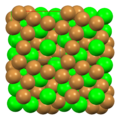Chemistry:Strontium bromide

| |
| Names | |
|---|---|
| IUPAC name
Strontium bromide
| |
| Identifiers | |
3D model (JSmol)
|
|
| ChemSpider | |
| EC Number |
|
PubChem CID
|
|
| UNII | |
| |
| |
| Properties | |
| SrBr2 | |
| Molar mass | 247.428 g/mol (anhydrous) 355.53 g/mol (hexahydrate) |
| Appearance | white crystalline powder |
| Density | 4.216 g/cm3 (anhydrous) 2.386 g/cm3 (hexahydrate) |
| Melting point | 643 °C (1,189 °F; 916 K) |
| Boiling point | 2,146 °C (3,895 °F; 2,419 K) |
| 107 g/100 mL | |
| Solubility | soluble in alcohol insoluble in ether |
| −86.6·10−6 cm3/mol | |
| Structure[1] | |
| Tetragonal | |
| P4/n (No. 85) | |
a = 1160.42 pm, c = 713.06 pm
| |
Formula units (Z)
|
10 |
| Hazards | |
| Main hazards | Corrosive |
| NFPA 704 (fire diamond) | |
| Related compounds | |
Other anions
|
strontium fluoride strontium chloride strontium iodide |
Other cations
|
Beryllium bromide Magnesium bromide Calcium bromide Barium bromide Radium bromide |
Except where otherwise noted, data are given for materials in their standard state (at 25 °C [77 °F], 100 kPa). | |
| Infobox references | |
Strontium bromide is a chemical compound with a formula SrBr2. At room temperature it is a white, odourless, crystalline powder. Strontium bromide imparts a bright red colour in a flame test, showing the presence of strontium ions. It is used in flares and also has some pharmaceutical uses.
Preparation
SrBr2 can be prepared from strontium hydroxide and hydrobromic acid.
- [math]\displaystyle{ \mathrm{Sr(OH)_2 + 2\ HBr \longrightarrow SrBr_2 + 2 \ H_2O} }[/math]
Alternatively strontium carbonate can also be used as strontium source.
- [math]\displaystyle{ \mathrm{SrCO_3 + 2 \ HBr \longrightarrow SrBr_2 + H_2O + CO_2 \uparrow} }[/math]
These reactions give hexahydrate of SrBr2, which decomposes to dihydrate at 89 °C. At 180 °C anhydrous SrBr2 is obtained.[2]
Structure
At room temperature, strontium bromide adopts a crystal structure with a tetragonal unit cell and space group P4/n. This structure is referred to as α-SrBr2 and is isostructural with EuBr2 and USe2. The compound's structure was initially erroneously interpreted as being of the PbCl2 type,[3] but this was later corrected.[4][1]
Around 920 K (650 °C), α-SrBr2 undergoes a first-order solid-solid phase transition to a much less ordered phase, β-SrBr2, which adopts the cubic fluorite structure. The beta phase of strontium bromide has a much higher ionic conductivity of about 1 S cm−1, comparable to that of molten SrBr2, due to extensive disorder in the bromide sublattice.[1] Strontium bromide melts at 930 K (657 °C).
Space-filling model of the packing of Sr2+ and Br− ions in α-SrBr2
Distorted square antiprismatic coordination geometry of crystallographically independent strontium atom number 1
Square antiprismatic coordination geometry of strontium number 2
Tetrahedral coordination geometry of bromine number 3
See also
References
- ↑ 1.0 1.1 1.2 Hull, Stephen; Norberg, Stefan T.; Ahmed, Istaq; Eriksson, Sten G.; Mohn, Chris E. (2011). "High temperature crystal structures and superionic properties of SrCl2, SrBr2, BaCl2 and BaBr2". J. Solid State Chem. 184 (11): 2925–2935. doi:10.1016/j.jssc.2011.09.004. Bibcode: 2011JSSCh.184.2925H.
- ↑ Dale L. Perry, Sidney L. Phillips: Handbook of Inorganic Compounds. CRC Press, 1995, ISBN:978-0-8493-8671-8, (Strontium bromide, p. 387, at Google Books).
- ↑ Kamermans, M. A. (1939-12-01). "The Crystal Structure of SrBr2.". Zeitschrift für Kristallographie - Crystalline Materials (Walter de Gruyter GmbH) 101 (1–6): 406–411. doi:10.1524/zkri.1939.101.1.406. ISSN 2196-7105.
- ↑ R. L. Sass (1963). "The crystal structure of strontium bromide". J. Phys. Chem. 67 (12): 2862. doi:10.1021/j100806a516.
 |









